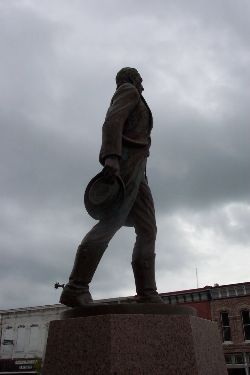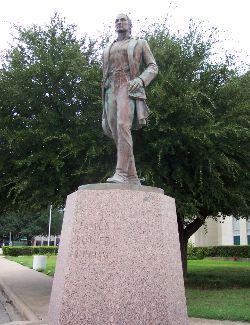JAMES BUTLER BONHAM
(1807-1836)
James Bonham, officer of the Alamo garrison, son of James and Sophia Butler (Smith) Bonham, was born at Red Banks (present-day Saluda), Edgefield County, South Carolina, on February 20, 1807.

Recent evidence indicates that he was a second cousin of William B. Travis.
Bonham entered South Carolina College (later the University of South Carolina) in the fall of 1823 but never graduated. During his senior year he led a student protest against the poor food served at the college and the obligation of students to attend class in bad weather. He and a number of other students, perhaps the entire senior class, were expelled.
Bonham took up the study of law and began practicing in Pendleton, South Carolina, in 1830. On one occasion he caned an opposing lawyer who insulted Bonham's female client. When ordered to apologize by the judge, Bonham threatened to tweak the judge's nose and was promptly sentenced to ninety days for contempt of court.
In 1832, during the nullification crisis, Bonham served as an aide to South Carolina governor James Hamilton, a position that brought him the rank of lieutenant colonel. At the same time he served as captain of a Charleston artillery company. By October 1834 he was practicing law in Montgomery, Alabama. On October 17, 1835, he led a rally of support for the Texan cause at the Shakespeare Theater in Mobile. Three days later he was elected by citizens of Mobile to carry their resolutions of support to Sam Houston. In another two weeks he was organizing a volunteer company, the Mobile Grays, for service in Texas.
Bonham reached Texas in November 1835 and quickly involved himself in political and military affairs. On December 1, 1835, he wrote to Sam Houston from San Felipe volunteering his services for Texas and declining all pay, lands, or rations in return. On December 20, 1835, he was commissioned a second lieutenant in the Texas cavalry, but apparently was not assigned to any specific unit. He had time to set up a law practice in Brazoria and was advertising the fact in the Telegraph and Texas Register by January 2, 1836.
Bonham and Houston quickly developed a mutual admiration. After being in Texas for only one month Bonham recommended to Houston that William S. Blount of North Carolina be granted a commission as a captain in the Texas cavalry. On January 11, 1836, Houston recommended to James W. Robinson that Bonham be promoted to major, for "His influence in the army is great–more so than some who `would be generals'." Bonham probably traveled to San Antonio de Béxar and the Alamo with James Bowie and arrived on January 19, 1836. On January 26 he was appointed one of a committee of seven to draft a preamble and resolutions on behalf of the garrison in support of Governor Henry Smith. On February 1 he was an unsuccessful candidate in the election of delegates to represent the Bexar garrison at the Texas constitutional convention.
He was sent by Travis to obtain aid for the garrison at Bexar on or about February 16, 1836. He returned to the Alamo on March 3, bearing through the Mexican lines a letter from Robert M. Williamson assuring Travis that help was on its way and urging him to hold out. Bonham died in the battle of the Alamo on March 6, 1836. He is believed to have died manning one of the cannons in the interior of the Alamo chapel.
Bonham's life and role in the siege and battle of the Alamo have been romanticized more than that of any other defender. He has often been portrayed as a colonel and one of the commanders of the Alamo garrison. He is called "Colonel" by Travis in two letters from the Alamo, but this was only a title of respect dating back to his days with the South Carolina militia. His actual rank was second lieutenant, and he had no standing in the Alamo's chain of command. He was present sporadically at the Alamo. Bonham is wrongly remembered as bringing the news that Colonel Fannin was not coming to Travis's aid, when he actually brought word from Williamson that help was coming.

In 1956 the Texas Centennial Commission erected a statue of Bonham on the courthouse square of the town of Bonham, named in his honor.
- Recommended citation: